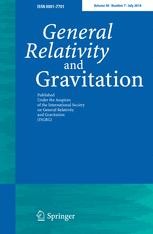GRG Editor's Choice: Cosmological solutions with charged black holes
 Bibi, R., Clifton, T. & Durk, J., Cosmological solutions with charged black holes, Gen Relativ Gravit (2017) 49: 98. doi:10.1007/s10714-017-2261-4
Bibi, R., Clifton, T. & Durk, J., Cosmological solutions with charged black holes, Gen Relativ Gravit (2017) 49: 98. doi:10.1007/s10714-017-2261-4
Open Access | Editor's Choice (Research Article)
First Online: 30 June 2017
"This article contains an investigation of the role of electric charge in cosmology, and in particular its consequences on the backreaction problem, through the construction of a class of exact solutions containing arrays of charged black holes. This is a solid piece of work which definitely adds to the current knowledge, expanding the set of known, (instantaneously) static configurations of charged black holes."
Abstract:
We consider the problem of constructing cosmological solutions of the Einstein–Maxwell equations that contain multiple charged black holes. By considering the field equations as a set of constraint and evolution equations, we construct exact initial data for N charged black holes on a hypersphere. This corresponds to the maximum of expansion of a cosmological solution, and provides sufficient information for a unique evolution. We then consider the specific example of a universe that contains eight charged black holes, and show that the existence of non-zero electric charge reduces the scale of the cosmological region of the space. These solutions generalize the Majumdar–Papapetrou solutions away from the extremal limit of charged black holes, and provide what we believe to be some of the first relativistic calculations of the effects of electric charge on cosmological backreaction.
The authors:
Jessie Durk is currently a PhD student, researching theoretical cosmology with Dr Timothy Clifton, lecturer at Queen Mary University London. Rashida Bibi is a faculty member of the International Islamic University, Islamabad.
GRG Editor's Choice:
In each volume of GRG, a few papers are marked as “Editor’s Choice”. The primary criteria is original, high quality research that is of wide interest within the community.
